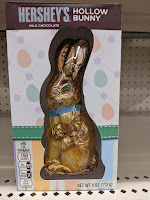 |
| Recent upgrade |
 |
| Tradition! |
Instead of ham, my wife's favorite Easter tradition is receiving a chocolate bunny. It has to be quality milk chocolate. When she unwraps it the first part to be eaten are the ears. After the ears, there is no particular portion which comes next. Yet, like an excellent ham, it is nibbled on at various times until it is all gone. At least she does not make sandwiches from the bunny parts!
In 1890, a drug store owner named Robert L. Strohecker displayed what is said to be the first chocolate rabbit in the United States. It stood 5 feet tall. From that point forward the fascination with chocolate bunnies rose even higher. Those who research chocolate bunnies indicate that in 1939, the bunnies began to have hollow interiors. It was a product change which provided easier eating, as well as using less chocolate. Biting through chocolate with a thickness of more than a half inch is extremely difficult, a chocolatier stated. Then in 1942, chocolate bunnies were banned due to the rationing of cocoa for the military. After World War II, the production and sale of these springtime treasures grew faster than rabbits propagate!
 |
| Hollow tradition! |
In the United States in 2017, 90 million chocolate bunnies were produced. Those who observe such things reported that over 70% of Americans eat the ears first. (My wife is normal after all!) According to the National Retail Federation, in 2021, the average family expenditure for Easter related food and candy was almost $180. Finally, Easter is second to Halloween in candy sales.
Not only are ham and chocolate bunnies interesting, but the Easter Hare backstory is intriguing, as well. According to research by Time, the origins are from one or both legends (English and Germanic) about the Goddess of Spring. These stories are about fertility, new life, change, etc. The Germanic version is the tale of Ostara, who transformed a bird into a hare. The hare produced colored eggs. These eggs would be left at night for the "good" children to find in the morning. Mindful children would leave carrots in a nest to help the Osterhase (Easter Hare) maintain its strength for the journey of delivering eggs. (Connection to the Santa legend with milk and cookies?)
 |
| Too sweet! |
On a practical level, some scholars believe eggs were hard boiled during the six weeks of the Lenten season for preservation. Due to giving up animal products/proteins during this time, eggs needed to be preserved. Once Lent concluded with Easter, eggs were distributed freely. Some of the eggs were colorfully decorated to symbolize their being special gifts. This was especially noticeable to the peasants who received the oval produce. Wealthier people resumed eating meat and dairy while the impoverished received eggs.
Church sponsored Easter egg hunts, hard boiled eggs for Easter breakfast, folktales of egg delivering rabbits, as well as gift filled, nest-like baskets make for a fascinating melding of traditions which have no connection to the Biblical New Testament account of the resurrection of Jesus of Nazareth. Is this a bad thing? I do not find it necessary to take a stand about such matters. Humans blend and incorporate traditions from cultures, families, and individuals constantly. We use stories to explain many things. Fascinating, creative, retold stories become the basis for many aspects of life we assume to be true. What is sacred to one group may be ridiculous to another. What is important for an era may be modified or forgotten in the next. What I find key to all of this is the aspect of relationship. We live in community, not isolation. We are enriched, enlivened, and expanded through the sharing of ideas and traditions. In my opinion this is much healthier than rigid, mono-cultural entrenchment.
So, I will celebrate life today while sharing caramel rolls, glazed ham, and those little eggs filled with peanut butter brought to me by the M&M character!

No comments:
Post a Comment